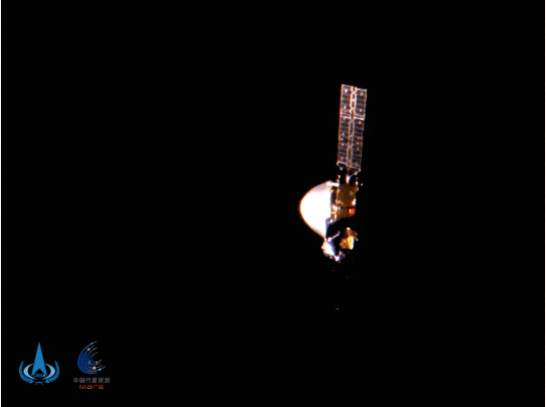

China's Tianwen-1 spacecraft on its way to Mars. Credit: CNSA/CLEP
The CNSA (Chinese National Space Agency) has released an image of its Tianwen-1 spacecraft to coincide with the National Day and Mid-Autumn Festival. The spacecraft is on its way to Mars, and if the landing is successful, China will be only the third nation to successfully land a spacecraft on the planet.
The image shows Tianwen-1 (translation: “heavenly questions”) with its solar panels deployed against the deep blackness of space. It’s about 24 million km (15 million miles) away now, and China says that it’s operating well.
A blog associated with the mission praised the Tianwen-1 mission with language which can sound to Western ears like propaganda from 60 years ago.
“The golden breeze is cool, the sky is clear and the moon is full. On the occasion of the National Day and Mid-Autumn Festival, the National Space Administration released the flight images of the Tianwen-1 probe of my country’s first Mars exploration mission. The five-star red flag on the map is dazzling, showing a bright Chinese red.” They also write “The silver landing patrol device and golden orbiter in the vast universe are shining brightly, and Tianwen No.1 uses this to report safety to the motherland and send birthday wishes.”


China’s China, and that’s the way the government talks to the people. But in any case, the Tianwen-1, and China’s space program overall, is a great achievement for the country. There’s nothing wrong with some pride.
The image shows the two main sections of the spacecraft. The silver part is the orbiter, and the golden part is the lander. The overall mission goal is to search for evidence of past and present life and to study the Martian environment.
The lander will use a parachute and retrorockets to perform its landing in the Utopia Planitia region. It’ll be solar-powered, and will analyze the soil chemistry, and look for biomolecules and biosignatures.
The selfies were taken by a small wide-angle camera released from the spacecraft. The camera had no other purpose and is now space junk.
The orbiter’s mission is scheduled to last 90 days, and the orbiter is scheduled to last for two years.
But landing on Mars is a daunting task. NASA’s good at it, but other nations and agencies have struggled. The Soviet Union is the only other country to do it, and that was decades ago. They managed to land spacecraft there in 1971 and 1972.
If the mission is successful, it has the potential to advance the understanding of Mars. The Tianwen-1 lander has a suite of six instrument, including a ground-penetrating radar that can reach depths of 100 metres (330 ft) below the Martian surface. And the orbiter has seven instruments.
Tianwen-1 won’t have Mars to itself though. Along with the other orbiters and landers that are already there, Tianwen-1 is one of three spacecraft that will reach Mars around the same time. The others are NASA’s Perseverance Rover and the United Arab Emirates Hope orbiter.
China has come a long way in its drive to modernize itself and set its own course. The space program is both a symbol and a result of that modernization, and is scientifically relevant too.
“We will embrace the new era, shoulder new missions, and embark on a new journey,” the blog post says. “Under the strong leadership of the Party Central Committee with General Secretary Xi Jinping at the core, we will march forward in great strides in the journey of the great rejuvenation of the Chinese nation and continue to make Chinese contributions to the peaceful development of mankind.”
Many of us who watched MSL Curiosity land successfully on Mars all those summers ago felt chills down our spines when word got back that the lander was safe. Chinese people will likely feel the same thing if Tianwen-1 is successful. The rest of us might, too.
Good luck, Tianwen-1.
Well that’s ruined all my lectures! I’ve spent years talking about space and a go…
According to Darwin, life on Earth may have first appeared in warm little ponds. This…
The habitable zone is where planets could have liquid water on their surfaces, but not…
Air travel produces around 2.5% of all global CO2 emissions, and despite decades of effort…
Researchers study enigmatic asteroid Kamo'oalewa, as China’s first asteroid sample return mission moves toward launch.…
In 2007, astronomers discovered the Cosmic Horseshoe, a gravitationally lensed system of galaxies about five-and-a-half…